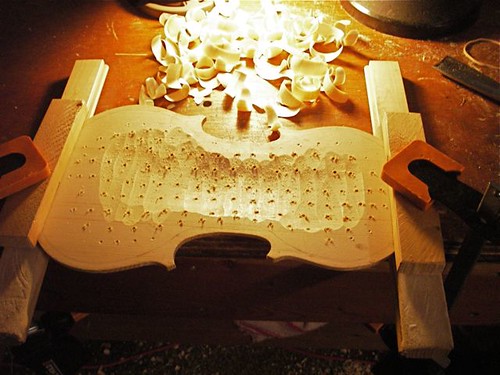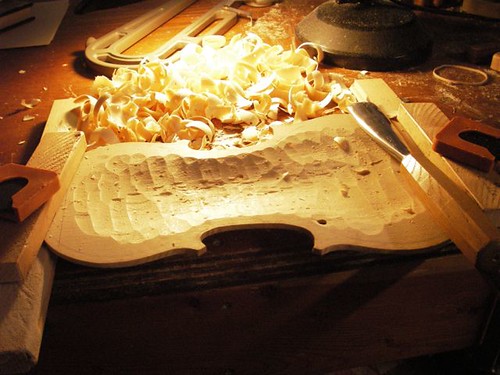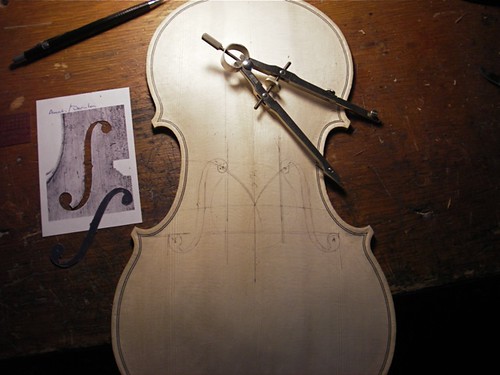With all the pieces finished, it's a matter to put them together. Glueing the plates to the rib assembly (after it's been removed from the form) is fairly straight-forward. You need to be a little careful to get the overhangs reasonably uniform, and to clean up any glue that gets onto wood that will later be varnished. Setting the neck is challenging -- lots of angles to get right, nothing flat to measure against, and you can't see it all until you get it where you want it.
But, we trudge onward --
To give the wood a little character, we expose it to UV. Nowadays, most builders seem to have nice UV boxes, and I want to build one, but right now I just do it the old way -- sunlight.
We're hot these days -- 6th day in a row at 100 degrees F or over, and the skies are a bit thick with smoke from surrounding wildfires. Here's a shot of the sky a couple evenings ago, with both thunderstorm clouds and smoke.
Of course, if I get even a hint of a thunderstorm, or even wind, I bring the fiddle indoors. Not interested in that sort of antiquing!
Showing posts with label f-holes. Show all posts
Showing posts with label f-holes. Show all posts
Thursday, July 12, 2012
Friday, June 29, 2012
Laying out and cutting f-holes
Using a few straight lines -- down the center, across the stop length (where the bridge will sit), and across at the low point of the c-bout purfling -- and circles of 32- and 64-mm, I'm trying to make the f-holes look right.
I'm using the lay-out scheme featured on Michael Darnton's website, as well as an image of a Brothers Amati f-hole he likes. Even with all that, I still end up adjusting it a bit by eye. And in doing so, hope to train my eye in the long-run. Finally, say 'good enough' and cut the holes.
At this point they've got something of the shape, but still a little too thin. How to decide that? I make them wide enough to get the soundpost through. I'm sure there must be a better criterion, but that works for now.
After a bit of clean-up work, I think I have them ok.
The poster below is of a 1666 Nicolo Amati, son of one of the Brothers Amati, and what I used as a model for my eye. Again, not a perfect copy by any means, but something I hope works and looks decent.
I'm using the lay-out scheme featured on Michael Darnton's website, as well as an image of a Brothers Amati f-hole he likes. Even with all that, I still end up adjusting it a bit by eye. And in doing so, hope to train my eye in the long-run. Finally, say 'good enough' and cut the holes.
At this point they've got something of the shape, but still a little too thin. How to decide that? I make them wide enough to get the soundpost through. I'm sure there must be a better criterion, but that works for now.
After a bit of clean-up work, I think I have them ok.
The poster below is of a 1666 Nicolo Amati, son of one of the Brothers Amati, and what I used as a model for my eye. Again, not a perfect copy by any means, but something I hope works and looks decent.
Monday, October 31, 2011
Under the top of the 1989 fiddle

The results of repeatedly adjusting a soundpost that doesn't fit -- damage to the spruce top. I've removed the bass-bar, here on the right side of the photo. You can also see the pattern of the sander/router marks left when the plate was hollowed at the factory, as well as the staining around the edges of the f-hole during blacking. These instruments were fit with cleats at the factory at each wing, to help prevent cracking, on would assume.
The router or sander marks are part of a tradition in these low-end student instruments. Before the machines were cheap and manageable, folks used gouges, quickly.

Labels:
bass bar,
f-holes,
graduation,
repairs,
Student instruments,
violin repair
Saturday, December 4, 2010
Cutting f-holes

Spent a couple hours cutting f-holes today. I carefully layout the stems, since the terminal holes are already drilled, and then basically cut the treble side carefully until a soundpost will fit through. Then I cut the bass side. And I try to make them match. One of the discussions that often pops up on violin-making forums are whether, when following the design of a classic violin, whether one should try to copy the asymmetry present, and whether it was due to design, or error, or age. I'm not that far along. I make my design as symmetric as I can, and the asymmetries come in on their own! :-)
Saturday, November 27, 2010
Hollowing the top
After messing about with the fine removal of wood on the outside arching, I find it great fun to gouge out big chips of wood, starting the hollowing on the top.

Before starting the hollowing, I layout the f-holes and drill the terminal holes on each end. This particular step takes me much more time than it should. I draw and redraw the f-holes several times before I get something I think will be ok. Once the holes are drilled, however, I'm committed.

I use a simple cradle to hold the top during hollowing.

The hole drilled in the bench and the hole in the top match -- while arching, I use a 3/8-inch dowel in the bench to hold the top in place, yet allowing me to rotate the top easily.
After getting some of the 'meat' out of the center, I set up my drill press for a rough graduation thickness. In this case, I've set the drill to leave a thickness of about 4 mm.

With the rough-graduation holes drilled, I can then again quickly scoop out most of the spruce, leaving just the 'tips' of the holes for reference. You can also see the previously drilled f-holes starting to be exposed, for example, on the lower hole next to the corner at the lower right, from this perspective.

Switching over to the larger thumb plane, I start smoothing the rough gouging.


Before starting the hollowing, I layout the f-holes and drill the terminal holes on each end. This particular step takes me much more time than it should. I draw and redraw the f-holes several times before I get something I think will be ok. Once the holes are drilled, however, I'm committed.

I use a simple cradle to hold the top during hollowing.

The hole drilled in the bench and the hole in the top match -- while arching, I use a 3/8-inch dowel in the bench to hold the top in place, yet allowing me to rotate the top easily.
After getting some of the 'meat' out of the center, I set up my drill press for a rough graduation thickness. In this case, I've set the drill to leave a thickness of about 4 mm.

With the rough-graduation holes drilled, I can then again quickly scoop out most of the spruce, leaving just the 'tips' of the holes for reference. You can also see the previously drilled f-holes starting to be exposed, for example, on the lower hole next to the corner at the lower right, from this perspective.

Switching over to the larger thumb plane, I start smoothing the rough gouging.

Wednesday, December 16, 2009
Design from nature
Thursday, October 22, 2009
Graduation of the top
Following a similar procedure, I drilled small holes to leave about 4 mm of thickness and started scooping out with a large gouge. Spruce is so easy to cut after maple. Takes about 15 minutes to get rid of 95% of the wood. Here we are a few minutes into the process.

After cleaning it up a bit with the large thumb-plane, I turn it back over and start laying out the f-holes. Doing it now allows for a little drill tear-out on the other side, which will be removed in the final graduation.

I'm using a mathematical method to lay-out the f-holes, modified by the location of the f-holes in the 1715 Stradivari "Titian", a photocopy of that area shown to the left. For something that looks relatively simple, it takes some juggling. You have to look at the sketched-out f-holes from all angles, just to get it where you think you want it. In this photo, I have the upper eyes 42 mm apart, which is a modern dimension. The "Titian" f-holes are 40 mm apart. I'd like to keep them at 42, to compare more directly with my previous violin, but finally decide to place them at 40, closed my eyes, and drilled the holes.

Discovered I didn't have any reasonable saw blades to cut the stems. Not willing to wait, I decided to use a plunge knife, cutting inside the pencil lines. When I get closer to the final graduation, I hope to be able to drop these stems out, and clean up the edges with a knife (which is what I'd have to do with saw-cuts anyway).

After cleaning it up a bit with the large thumb-plane, I turn it back over and start laying out the f-holes. Doing it now allows for a little drill tear-out on the other side, which will be removed in the final graduation.

I'm using a mathematical method to lay-out the f-holes, modified by the location of the f-holes in the 1715 Stradivari "Titian", a photocopy of that area shown to the left. For something that looks relatively simple, it takes some juggling. You have to look at the sketched-out f-holes from all angles, just to get it where you think you want it. In this photo, I have the upper eyes 42 mm apart, which is a modern dimension. The "Titian" f-holes are 40 mm apart. I'd like to keep them at 42, to compare more directly with my previous violin, but finally decide to place them at 40, closed my eyes, and drilled the holes.

Discovered I didn't have any reasonable saw blades to cut the stems. Not willing to wait, I decided to use a plunge knife, cutting inside the pencil lines. When I get closer to the final graduation, I hope to be able to drop these stems out, and clean up the edges with a knife (which is what I'd have to do with saw-cuts anyway).
Subscribe to:
Posts (Atom)








